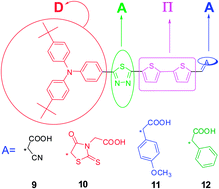Metal-free organic dyes containing thiadiazole unit for dye-sensitized solar cells: a combined experimental and theoretical study†
Abstract
We have designed and synthesized four new metal free D–A–π–A type dyes (9–12) with variations in their acceptor/anchor groups. The four dyes carry tert-butyl substituted triphenylamine as donor, thiadiazole as acceptor and bithiophene as π-spacer. Cyanoacetic acid, rhodanine-3-acetic acid, 2-(4-methoxyphenyl)acetic acid and 2-phenylacetic acid are used as acceptor/anchor groups, respectively in the dyes 9–12. The acceptor/anchor effect on their photophysical, electrochemical and photovoltaic properties was investigated. The dyes exhibited good power conversion efficiency ranging from 1.95–4.12%. Among the four dyes, 9 showed the best photovoltaic performance: short-circuit current density (Jsc) of 8.50 mA cm−2, open-circuit voltage (Voc) of 645 mV and fill factor (FF) of 0.75, corresponding to an overall conversion efficiency of 4.12% under standard global AM 1.5 solar light conditions.


 Please wait while we load your content...
Please wait while we load your content...